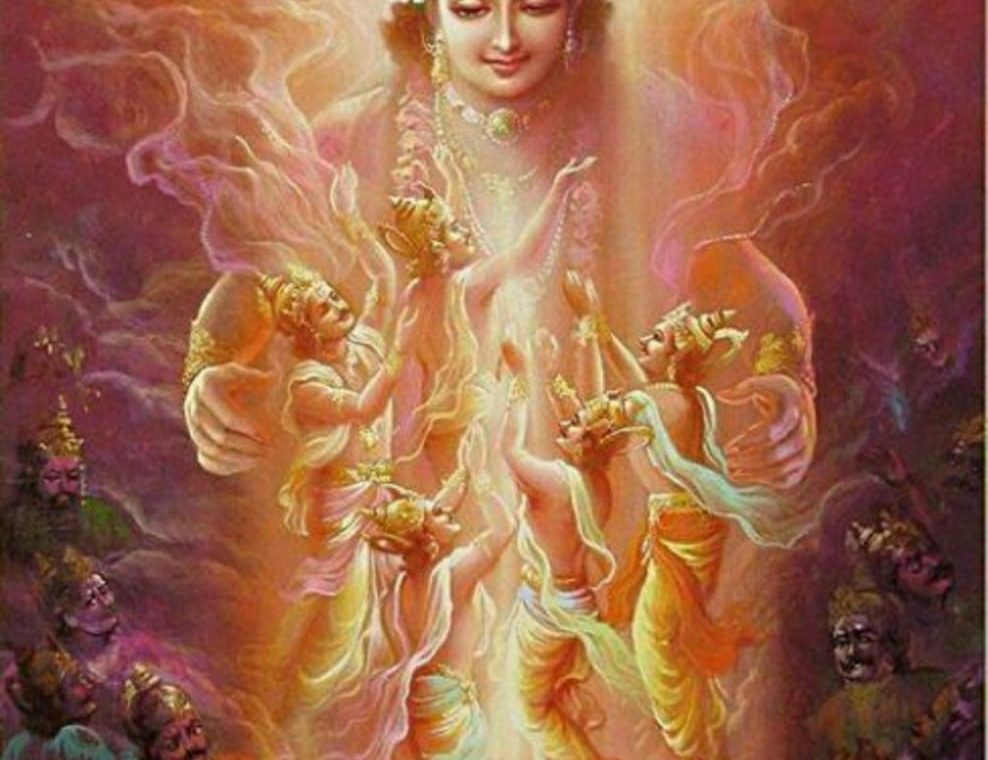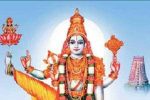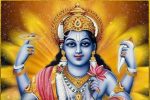NAME 54 & 55
Sthaviro स्थविरो - Dhruvaḥ -ध्रुवः
54. Sthavirah means most ancient or older than the oldest. It means that Bhagavan while causing the Universe to exist for millions of years is Himself timeless, ageless and changeless. Sri Adi Sankara takes Sthaviro Dhruvaha as a composite word – ‘Savisheshanamekamnaamam – a single Nama with a built in adjective’.
Sri ParasaraBhattar takes them as two separate Namas, one denoting fixed in time and the other denoting fixed in space.
The composite meaning is the same for both the commentators.
55. Dhruvah
He is Stable or Eternal
Dhruvah means fixed, stable and unmoving. Even after creating so many lives, things and objects, Bhagavan remains whole, stable and unchanged. While the clay may become pot and change its form, Bhagavan remains the same even after using his energy for all his Creations. There is not even a slightest depreciation in his form.
Sthavira means ancient and dhruva means eternal. This nāma says that the Brahman is ancient and eternal. He is ancient because He is ādi and anādi.
Bhagavad Gita (VIII.20) says, “Far beyond this unmanifest, there is yet another Unmanifest, which is Eternal and does not get destroyed even when the entire beings are annihilated.”
This nāma reaffirms Him as the Brahman. Brahman does not need affirmations and confirmations. Ancient sages thought that incomprehensible Brahman should at least be elucidated with the highest degree of everything. This is the reason for such reference to the Brahman. The repetitive expressions make one understand the concept of the Brahman and His Supremacy.
This nāma says that Brahman is the most ancient in this universe. The superlative degree is used here because, nobody knows the origin of the Brahman. He always exists. He exists even during the great deluge because the whole universe is absorbed into Him.
परस्तस्मात्तु भावोऽन्योऽव्यक्तोऽव्यक्तात्सनातन: |
Bhagavad Gita: Chapter 8, Verse 20
य: स सर्वेषु भूतेषु नश्यत्सु न विनश्यति || 20||
paras tasmāt tu bhāvo ’nyo ’vyakto ’vyaktāt sanātanaḥ
yaḥ sa sarveṣhu bhūteṣhu naśhyatsu na vinaśhyati
Translation
BG 8.20: Transcendental to this manifest and unmanifest creation, there is yet another unmanifest eternal dimension. That realm does not cease even when all others do.
Commentary
After completing His exposé on the material worlds and their impermanence, Shree Krishna next goes on to talk about the spiritual dimension. It is beyond the scope of the material energy, and is created by the spiritual Yogmaya energy of God. It is not destroyed when all the material worlds are destroyed. Shree Krishna mentions in verse 10.42 that the spiritual dimension is three-fourth of God’s entire creation, while the material dimension is one-fourth.
५४. ॐ स्थविराय नमः।
&
५५. ॐ ध्रुवाय नमः |
54 OM Sthavirāya Namah
55. Om Dhruvāya Namaḥ
(54) SthaviroDhruvah -The Ancient (Sthavirah) and the Motionless or firm (Dhruvah). He is called the ‘Ancient’ because the very first ‘unit of time’ itself had risen from Him. He was the progenitor of the very concept of Time in us. Therefore, ‘Time’ cannot condition Him. Thus He becomes the most Ancient. He is the ‘Firm Truth’; nothing that happens in the phenomenal world can affect Him at any time. The ancient one who is eternal.
Sthavira The ancient One. Pra Viṣṇu rastutava sastavīyāntve ṣaṃhya syasthavira syanāma (R̥gveda 7.100.03) ‘for celebrated is the only name of this ancient One’ is the basis. Or ‘Sthavira’ also implies aging or aged one. Thus Viṣṇu is the ancient one who is immeasurably aged. Dhruvaḥ eternal or firm is the qualifier. It is taken as a single phrase, the name along with its qualification.
INTERPRETATION GUIDED BY SANT VANI (WORDS OF SAINTS)
54. & 55. SthaviroDhruvaḥ
The ancient and unchanging.
We refer to monuments as ancient if they are a few hundred years old. People who have a life span of more than 80 years old, may be called old and ancient. But, they change and age with time and finally die; they are anitya.
Sthavira means purāṇa, ancient. It also means the oldest. From the human standpoint, the Lord is the most ancient and oldest, because there is none more ancient than Him. But anything that is old is subject to decline and finally death. To offset the limitation of the word sthavirah, the word dhruvaḥ is used along with it. The words Sthavira and Dhruva together go as one name made up of an adjective and a noun. Bhagavān, though the most ancient, does not age or change or die nor needs cosmetic surgery.
Therefore, He is Dhruva, unchanging and ever the same. As He was before, He is even now; He is always the same. He is sat-cit-ānanda-pūrna-svarūpa, ever full. Therefore, Sthavira here indicates, timelessness.
Old age is necessary, otherwise there will be no death and everyone will remain here on earth.
Then, there will not be any place for those who come in. The Lord is tvaṣṭā, is the clearing agent, a word referring to a function. Function implies action. At the same time He is Dhruva, Himself does not undergo any change.
The eternal ‘elder’, the ancient one who is perfectly “steady” and firm, fixed and immovable. The unchanging-ancient being of the Universe.
Śaṅkara considers these two names STHAVIRAḤ and DHRUVAḤ as one name, a compound word consisting of an adjective that qualifies or describes the associated Noun – i.e. “That ancient and eternal being who is firm, steady, and unshakable.” Parāsara Battar treats them as two separate names.
This name and its deep significance can be understood through a story from our Puranas:
There is the story of the young boy Dhruvaḥ in the Viṣṇu-Purana, who on being insulted by the second-wife of his father decides to ask Viṣṇu himself about his fate! In order to achieve this, he goes to the forest and starts to meditate on that ancient supreme being Viṣṇu who dwells within the heart-cave of every person. The divine sage Nārada tries to dissuade him, citing his young age and dangers of the forest but finally relents after he sees the determination of the young boy. The mantra he teaches the boy is ॐ नमो भगवते वासुदेवाय (Om Namo Bhagavate Vasudevaya) – the 12-syllable mantra that is considered the greatest of the Vaishnava mantras – “Dvadasharno maha mantrah pradhano Vaishnava game“
That little boy takes this mantra to heart and starts practicing the most difficult and unbroken meditation on this one mantra – such is his concentration that he forgets about food and water and all he sees is the divine form of that Supreme being manifested as Viṣṇu in his mind’s eye and dwelling in his heart. After several months of such intense Sādhanā, Viṣṇu himself appears before him but the boy refuses to open his eyes, lest he lose the connection to the Supreme being. Viṣṇu has to then play a trick to ensure the boy opens his eyes. When he finally opens his eyes, the boy is so wonder-struck that he cannot utter a word. Viṣṇu caresses the boy’s cheek with his conch and the boy pours out his devotion in the form of the brilliant Dhruvaḥ-Stuti. Viṣṇu blesses him with a permanent celestial place as the Dhruvaḥ- Nakṣatra.
The Dhruvaḥ-Nakṣatra is thought to be synonymous with the North Star or Pole Star – Polaris – This North Star is famous for pointing always to the true north and appears almost still in the sky above the Norther pole of the earth. It appears still even as the norther sky appears to move and circumambulate around it – this is again a good analogy for this name – the steady and firm being – Sthaviraḥ-dhruvaḥ. It is also a reflection on the fact that when we are deeply connected within to our own self, then even if the whole world moves around us, we can remain steady and keep our being pointed in right direction.
The story of Dhruvaḥ itself is a summary of the last few names discussed in this particular string – We are the architects of our lives (Viśwákarma), and shaping our is possible through deep and unbroken reflection on the inner-reality and choosing a mantra that we can hold on to (Manuḥ), it is for us to chisel and shape our lives with the help of the indwelling supreme being (Tvaṣṭā), leading to the expansion and inclusiveness in our own vision (Sthaviṣṭha) that makes us see the divine in all, and above all one needs to be as determined as a Dhruvaḥ to connect to that ancient and unchanging being whose nature is eternal and unchanging – Sthaviraḥ.
“Old age is inevitable for all blessed with a normal lifespan. When anything is inevitable, it means you only have two choices: first, handle it with grace and gratitude or second, deny it with griping and whining. Old age is like the Friday afternoon at work — it gets quiet, it slows down before the weekend break. And what is death? Well, death is the weekend. Consciousness moves on. If you believe in soul or rebirth, a new birth awaits you. If you believe in heaven or hell, who knows you may just live a life of your dreams in one of those places. If you don’t believe in anything, well then, hopefully you know your own answer.” – Om Swami



